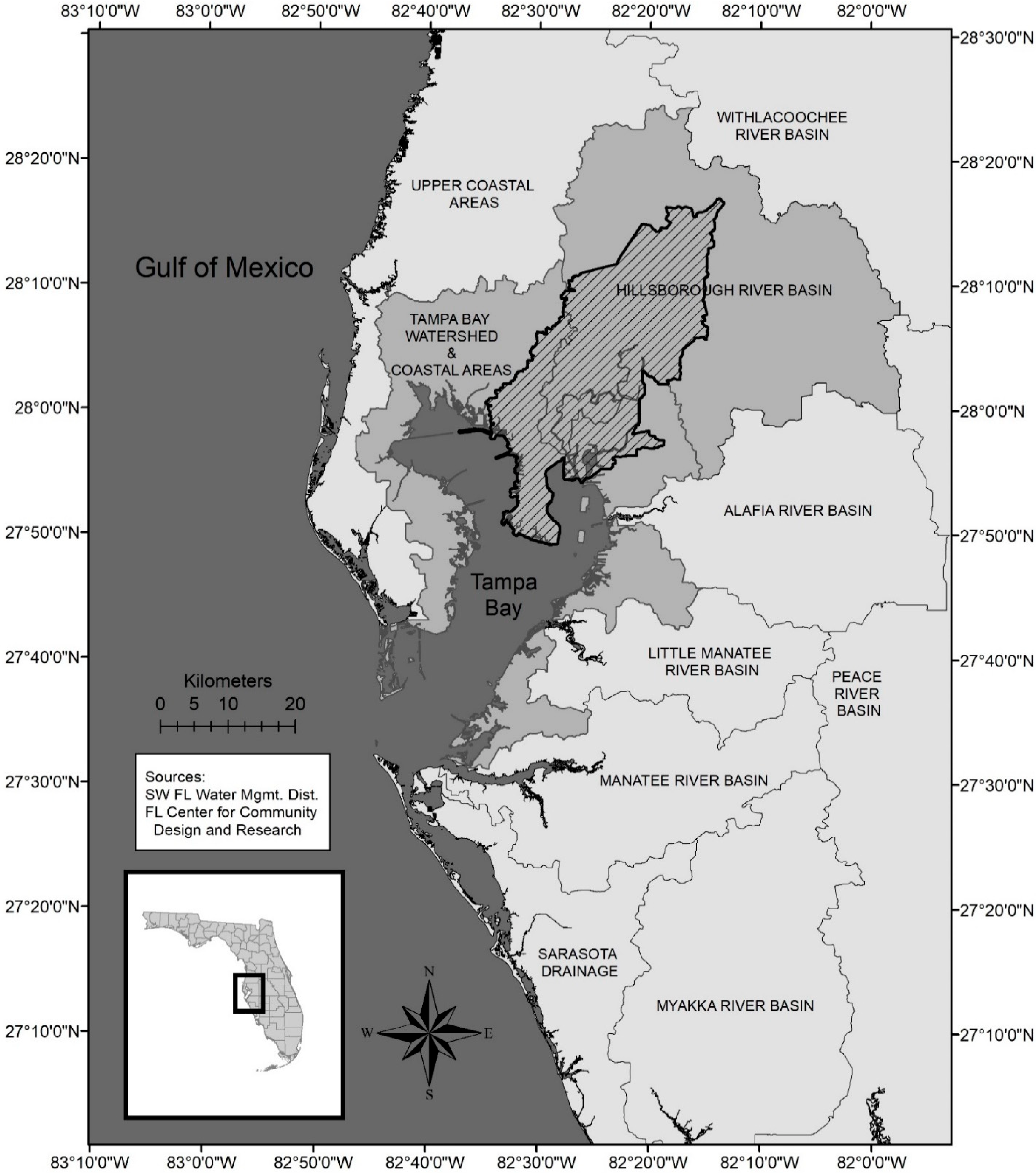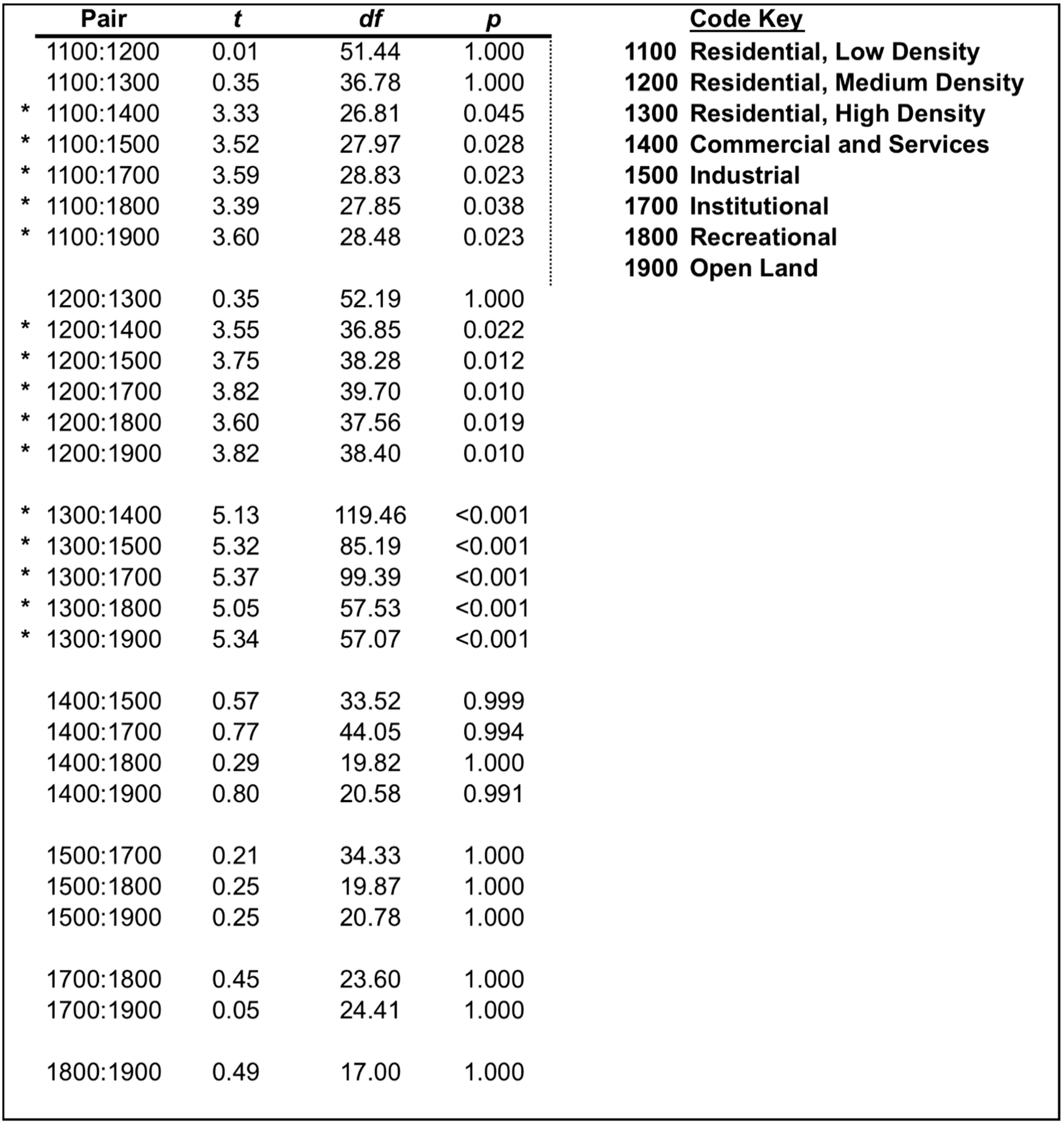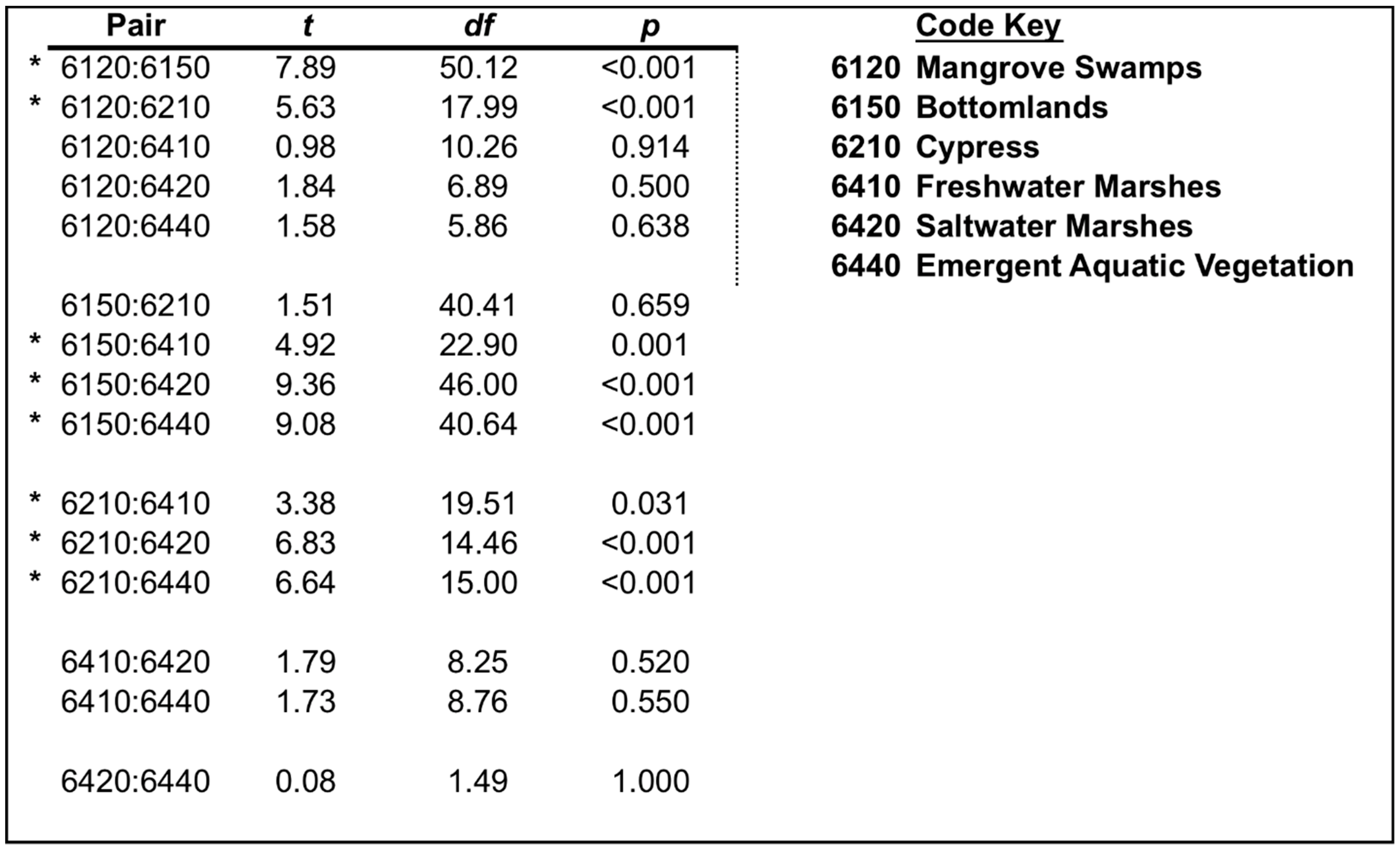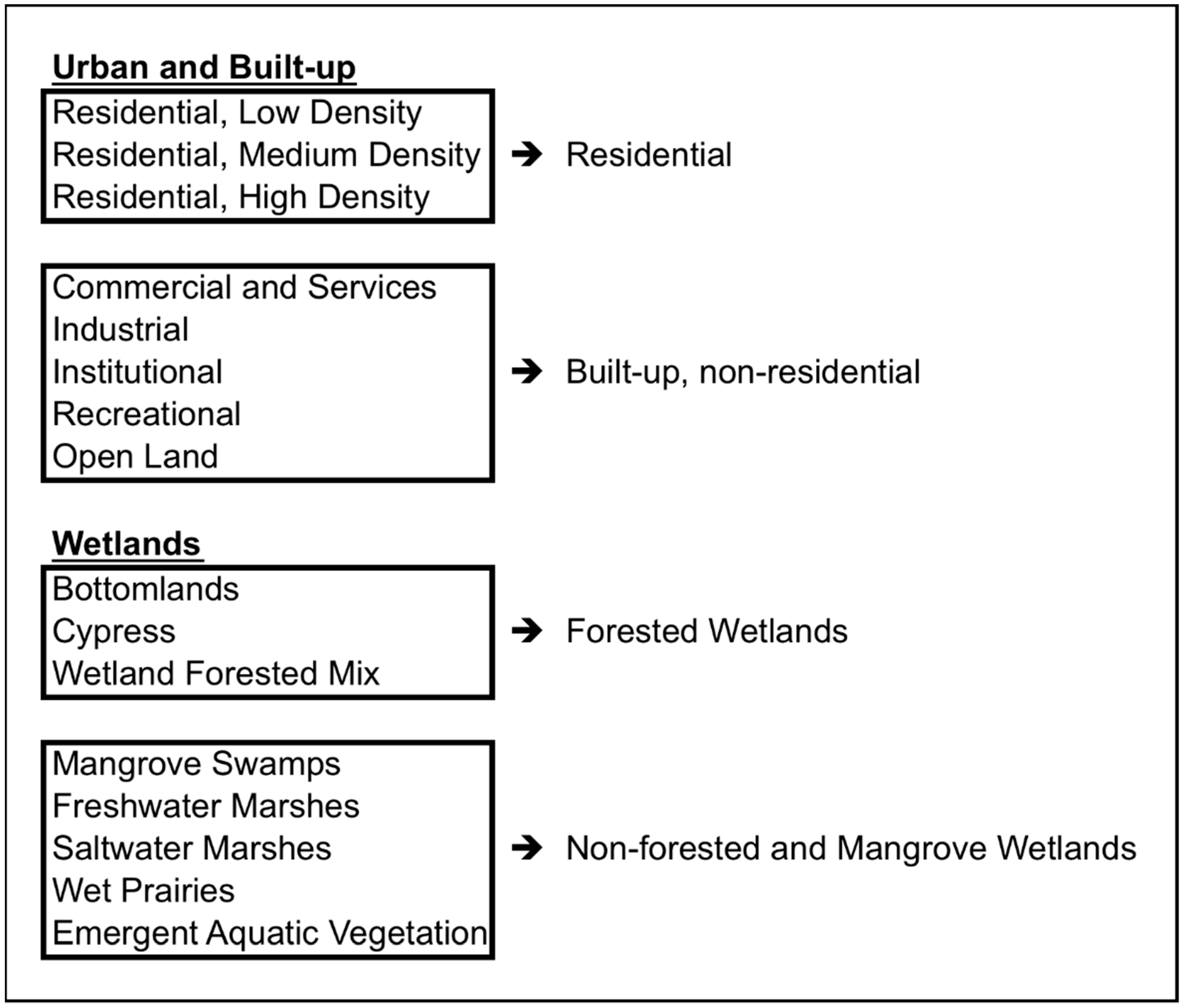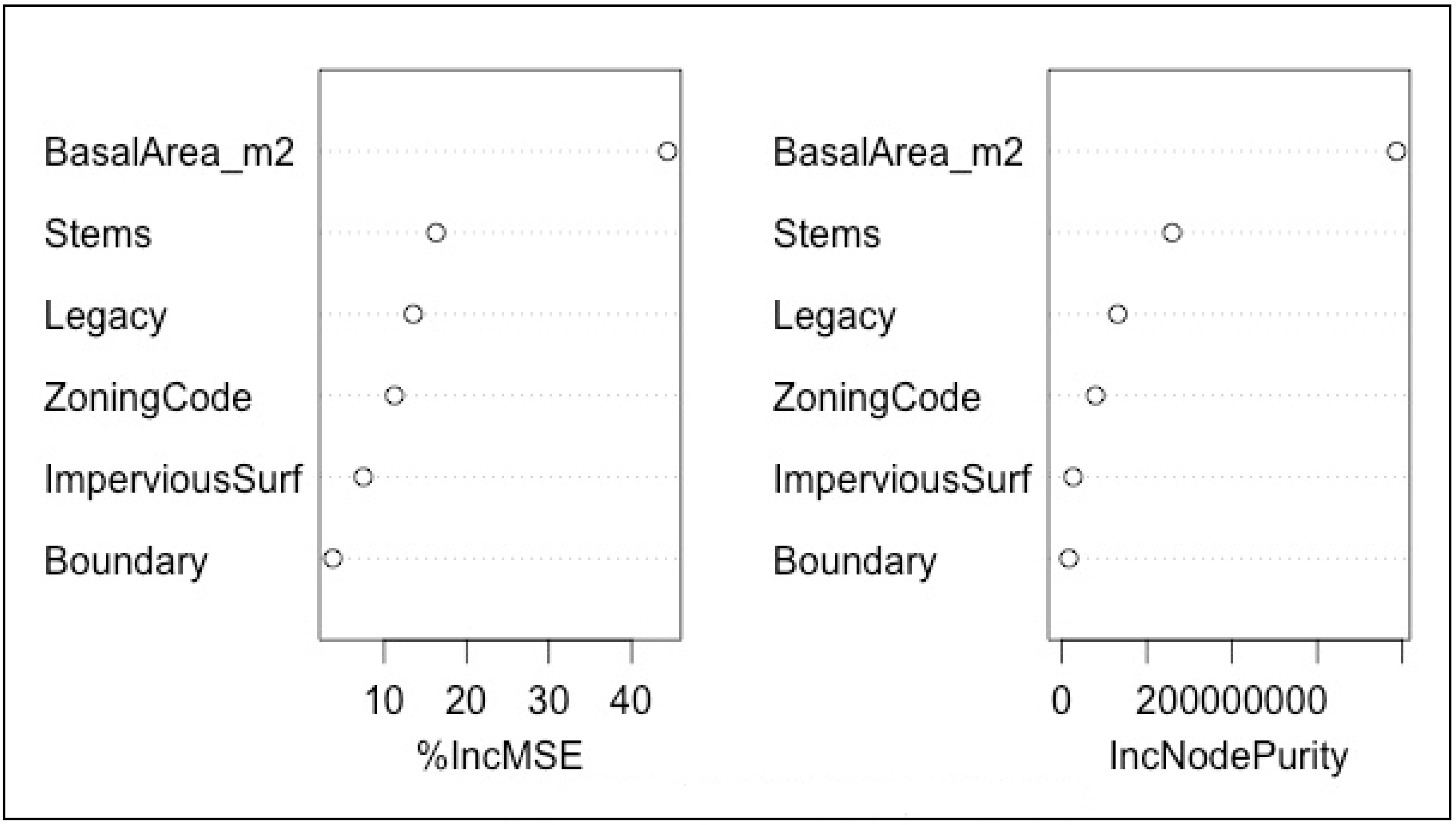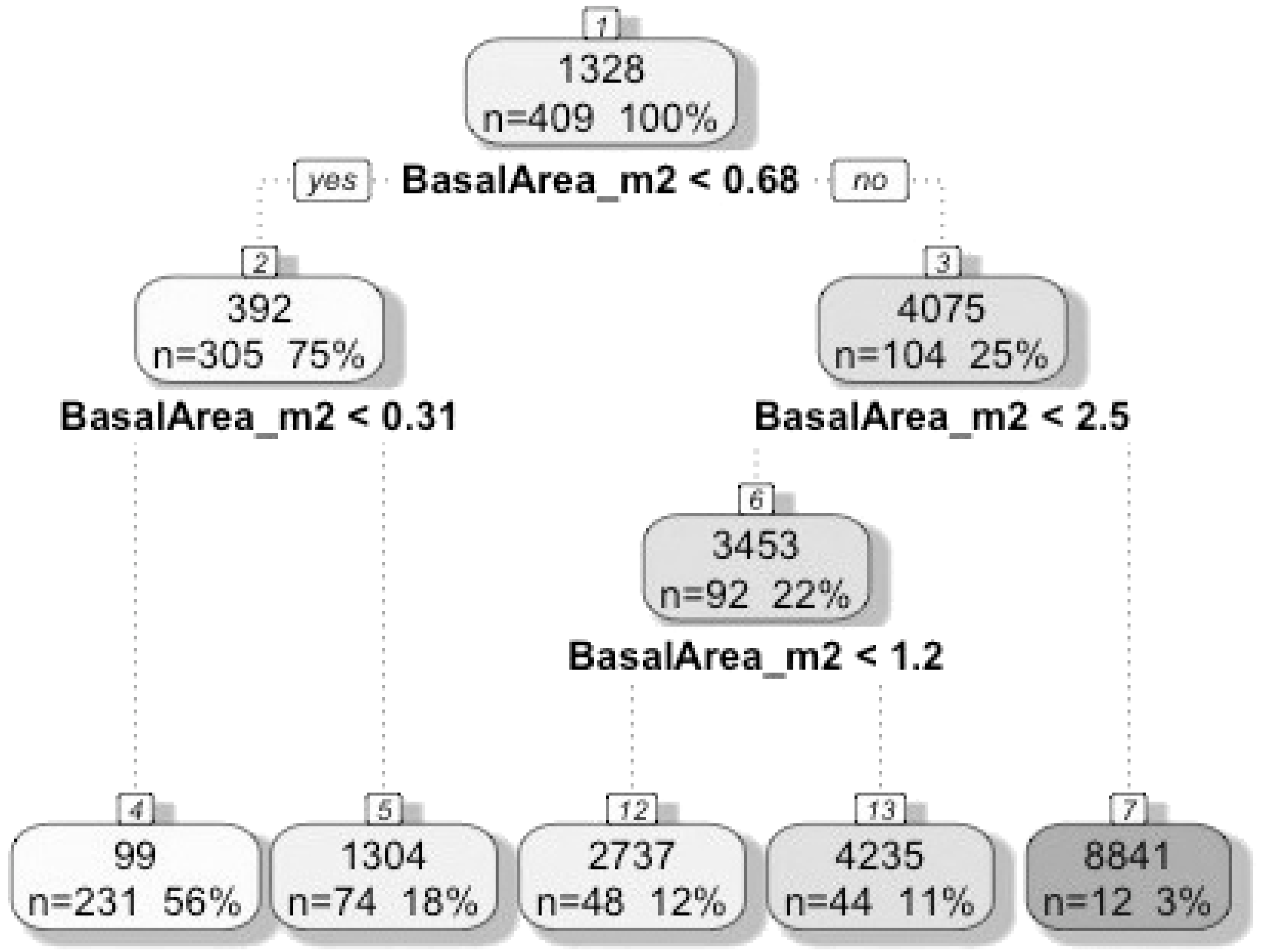Urban ecosystems are heterogeneous, complex mosaics of developed and vegetated areas with variable structure and dynamics [
1]. They are formed by anthropogenic land-use and land-cover (LULC) change, a primary driver of terrestrial carbon release [
2]. In the Tampa Bay area this often occurred through the conversion of forested areas into pasture/croplands [
3], and later in developed areas, with the expansion of urban areas from population growth [
4]. The impacts are widespread and include alterations to nutrient cycles, biodiversity, and climate change stemming from carbon dioxide (CO
2) emissions. Therefore, LULC change is one of the most significant impacts humans exert on their environment [
5].
Throughout its history, the United States has experienced near continuous urban expansion. In the modern era, urban regions have doubled in size since the late 1970s. They hold about 81% of the US population [
6,
7] using the Census Bureau’s definition of urban population density, which is 50,000 or more in a qualitatively defined area. Between 1950 and 1990, metropolitan areas, defined as urban centers and their surrounding counties, have tripled in size. They comprise an estimated 24.5% of land in the contiguous United States [
6]. It is further estimated that more than 50% of available land in the US has in some way been altered by humans [
8].
1.1. Urban Ecosystem Services
Significant attention has focused on urban forests as a source of ecosystem services (ESs), which contribute tremendous benefits to society [
9]. These include food, raw materials, energy, carbon storage, water filtration, and recreation, among others, many of which can be estimated in both real and economic terms [
10,
11]. Adjacent concentrations of human activity continuously alter the very ecological relationships and processes that provide these services [
12].
Interest in ES continues to grow, particularly for urban areas, with a large body of research that examines function and utility [
13,
14]. These include the identification, quantification, and monitoring of ES [
15], valuation as a set of economic goods and services [
16] and as tradeable commodities to mitigate environmental degradation, such as the Payments for Ecosystem Services framework [
17]. A review of the literature for 25 cities in Canada, China, and the United States found that the total monetary value of ecosystem service benefits ranged between USD 3212 and USD 17,772 ha
−1 [
9] in addition to less tangible environmental and cultural benefits including aesthetics, education, spiritual, health, and heritage among others [
18]. Carbon storage in particular is viewed as an important component to future climate change mitigation [
19] and a number of studies have estimated carbon storage for urban trees and soil [
20,
21,
22].
1.2. LULC Classifications
Landscape classifications are context specific and vary widely between studies and disciplines. Similar to all models, they are a simplification of reality that serve as a means to an end [
23]. In general, classifications can be thought of as both a scheme (class definitions) and the process of assigning landscape features into classes. LULC classifications are important components in many ES studies that seek to investigate the spatial patterns of ES and their use. For example, ES mapping investigates the spatial pattern of supply and demand by integrating statistical estimates with LULC data. This can allow for tracking and projections of ES use over time as well as space [
24]. Burkhard et al. [
25] conducted an ES mapping study to measure energy capacity for particular LULC classes. They applied an out-of-the-box classification scheme used by the European Union’s CORINE program. CORINE uses a hierarchical classification that begins with five broad classes spanning 44 sub-classes [
26]. In their discussion, Burkhard et al. [
25] recognized that the relationship between ES mapping and spatial scale is an area of ES research that requires attention. Moreover, the intensity of ES capacity across land-use types must be investigated to fully understand the spatial patterns of ES supply and demand [
27].
The spatial heterogeneity of urban ecosystems poses a challenge when selecting class criteria because urban areas occupy a comparatively small area and require large-scale resolution data for accurate detection. Still, one of the most widely applied and/or modified classifications for urban studies is the Anderson land-use system [
28,
29]. It was developed to standardize data for remote sensing techniques used by government agencies. The classification uses a hierarchy of levels that increase in detail. For example, the Level I category “Urban or Built-up Land” is further split into the following Level II classes: “Residential”, “Commercial”, “Industrial”, etc. This structure is repeated for all Level I categories, the rest of which refer to other land uses and covers: “Agriculture”, “Rangeland”, “Forest Land”, “Water”, “Wetlands”, “Barren land”, “Tundra”, and “Perennial Snow or Ice” [
29]. The model allows the option for user-defined Level III and Level IV classes pursuant to the needs of each study. Jensen [
30] described it as a “resource-oriented” classification in comparison to those that are “activity”-based. In this regard, it is useful for distinguishing urban lands from natural, but does not account for functional relationships within the landscape or the ability to understand the heterogeneity of urban landscapes at a finer scale [
31]. Instead, it describes landscape features more in terms of cover than use. Cadenasso et al. [
31] also noted that because the Anderson classification system was designed on a national scale, it lacks the ability to differentiate details within urban systems and therefore requires significant modification.
As an alternative, Cadenasso et al. [
31] proposed the High Ecological Resolution Classification for Urban Landscapes and Environmental Systems (HERCULES) developed to function at a “medium-scale” to balance small- and large-scale classifications such as Anderson and biotoping, respectively. HERCULES is meant to separate urban structure and ecological function so that relationships between them are apparent. This provides for the ecology “of” cities as opposed to ecology “in” cities [
32,
33] by characterizing three land cover elements (buildings, surface materials, and vegetation) divided into two categories that relate their influence on ecological function. Patches across the landscape are assigned proportions for each cover they contain, as well as the physical layout of buildings. It is suggested that HERCULES better integrates human and natural components and exposes differences between structure and function [
34]. However, Zipperer et al. [
35], while acknowledging the attempt of HERCULES to gauge the influence of built structures on ecological processes, criticized its labor intensity and large number of resultant patches.
Recent examples of novel methods for classifying urban, urbanizing, and developing areas include Shi et al. [
36], Solórzano et al. [
37], and Naushad et al. [
38]. Shi et al. combined multisource remote sensing data with social media data to better differentiate urban classes in Guangzhou, China. Solórzano et al. used deep learning algorithms, such as U-Net, with radar and multispectral imagery to assist in differentiating tree cover types. Naushad et al. compared the efficacy of a few different approaches with deep learning technologies with via transfer learning with EuroSAT data.
Many urban classifications have been developed for different areas and applications, but a full review is beyond the purpose of this introduction. For additional examples and discussions on urban LULC classifications please see Cadenasso et al. [
34], Grove et al. [
39], and Zipperer et al. [
35]. Landscape ecologists are calling for ideas to integrate biophysical and socioeconomic data with existing statistical approaches [
40], and it was shown that this is possible with classifications such as HERCULES. LULC classifications can greatly alter the results of a landscape analysis. Therefore, the questions asked in a study must dictate the classification used. For example, if LULC classifications describe the spatial variation in landscape features, and ES mapping describes the spatial distribution of these services, then the classes used to map ES should accurately represent the variation in ES under investigation.
1.3. Objectives
This study modifies an existing LULC classification to incorporate ES data for use in studies investigating ES across an urban landscape. Tree data and the Florida Land Cover Classification System were integrated to create a carbon-centric classification scheme [
41]. Changes in above-ground tree carbon (AGTC) storage for each class were estimated for the period 2006–2011. AGTC was estimated for individual trees using the Urban Forest Effects (UFORE) model and inventory data collected in 2006 and 2011. Estimates were then aggregated by class and scaled for the study area.
Section 2.1 to
Section 2.5 discusses the study area, data collection, and input datasets.
Section 2.6 discusses the statistical analyses to compare sub-classes for the plot data.
Section 2.7 and
Section 2.8 detail how the LULC classes were classified and then reclassified based on AGTC. Results for the initial classification and AGTC classification are detailed in
Section 3.1 and
Section 3.2, respectively. The post-hoc analyses to compare classes are discussed in
Section 3.3. The structural classification using a decision tree is discussed in
Section 3.4 while the final reclassification is detailed in
Section 3.5.
